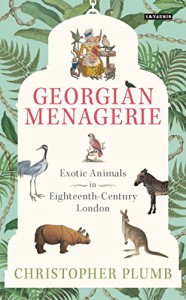All creatures big and small of the exotic sort and the effect they had on the imagination of Londoners.

My thanks to I.B. Tauris & Co. and Net Galley for providing me a copy of this book in exchange for an honest review.
This is a fascinating book. I’m one of those people who find the history of the good and great all very well but I’m more interested in what everybody else and society at large was up to while the battles and big political debates took place. And the more curious the topic and the angle used to shine a light on an era, the better.
Christopher Plumb’s choice of topic works well on many levels. Most of us have been fascinated by animals when we were children (and into adult life, whether we admit it or not), and the more exotic to us, the better. Imagining a period in history when many westerners would have never seen a parrot, a kangaroo, or a lion, might be difficult now, but it wasn’t all that long ago. The circumstances of the exhibition and sale of many of these animals provide a fascinating insight into human curiosity, enterprise, and society. And it goes from the Royals to the people who would manage to get a few shillings to pay for a ticket to see the latest attraction. If not everybody could afford their own aviary or menagerie at home, towards the end of the era canaries were affordable by many. The topic is well-researched, with beautiful illustrations of the period, references and footnotes for those interested in further enquiry, but it never becomes arid or tedious. This is not a list of sources and data. The era, the personalities of the merchants, anatomists, and even the animals are brought to life through anecdotes, fragments of poems, songs, newspaper articles, letters…Although readers might not share the point of view and feelings of the people of the period, it’s easy to imagine being there and looking on.
We learn about the uses of bear grease, civet as perfume, turtle feasts as symbols of power, eels and sexuality, parrots and jokes about women, Queen Charlotte’s zebras and the jokes to follow, the prices of animals and tickets in relation to salaries, the opinions of the general population about their monarchs, sexual mores and allusions, famous elephants, sickly giraffes, lions roaring in London’s Strand, the Tower of London menagerie, and how all changed with the arrival of the Zoological Garden at Regent’s Park. Christopher Plumb draws interesting conclusions (or rather guides the reader to notice certain things) that emphasise how the external manifestations of human nature might change, but at heart, perhaps we aren’t that different from our ancestors and we’re not as enlightened and modern as we’d like to think.
This book can be enjoyed by all readers, even if they don’t know much about the Georgian period of English history (also referred in the book as the long eighteenth century), but I think it will be an invaluable resource to anybody studying or researching the era, as it provides vast amounts of background and information (without seemingly doing so) from an unexpected angle, and many of the anecdotes could become full stories in themselves. Vividly described, each chapter can be read individually for specific research purposes, but I feel the whole is much more than the sum of its parts.
A book that will keep me thinking for a long time.
 1
1







